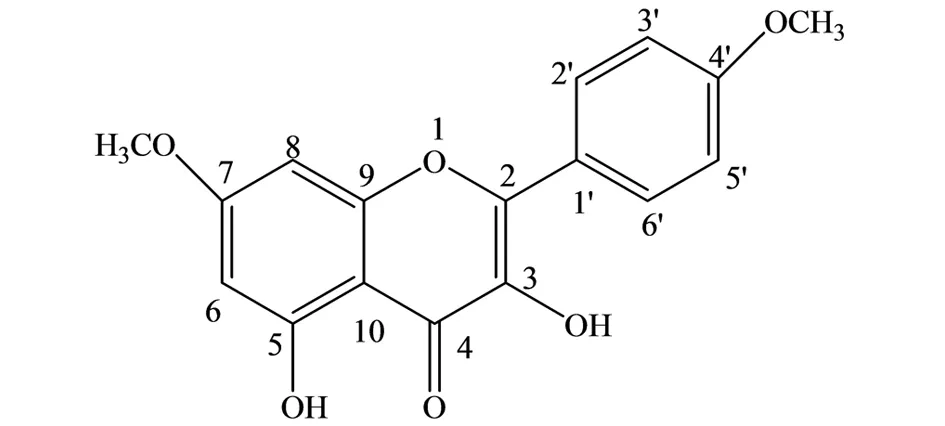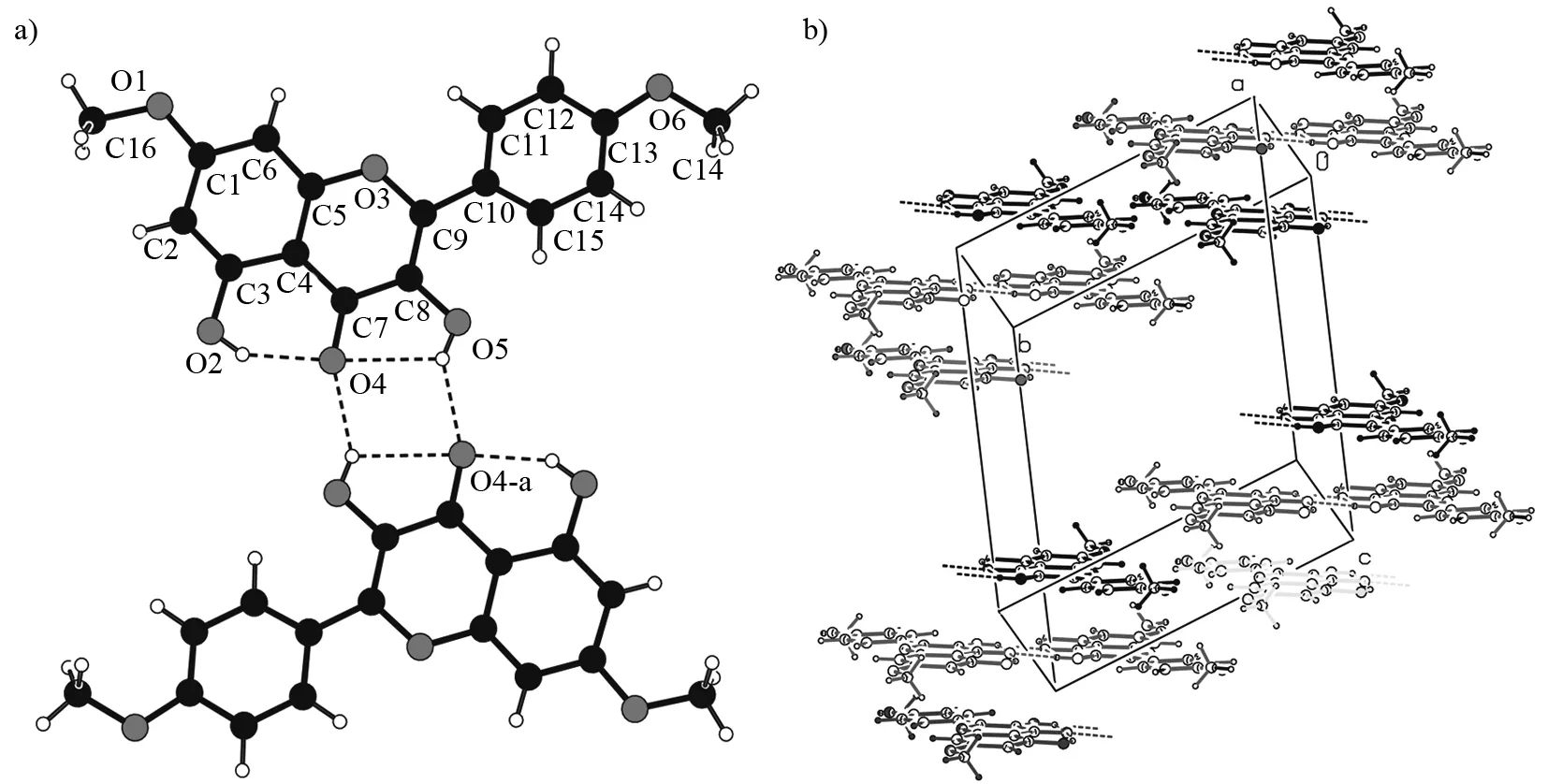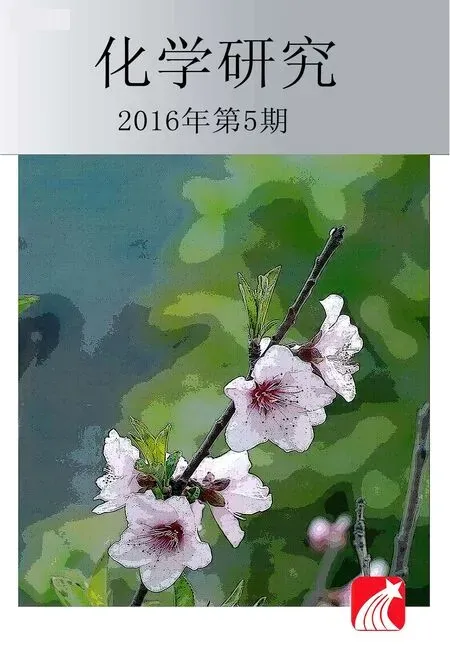Crystal structure of 3,5-dihydroxy-7,4′-dimethoxy flavone
2016-10-25WANGYongQINGWeixiaZHAODongbao
WANG Yong, QING Weixia , ZHAO Dongbao*
(1. Institute of Environmental and Analytical Sciences, College of Chemistry and Chemical Engineering, Henan University,Kaifeng 475004, Henan, China; 2. Medical College, Henan University, Kaifeng 475004, Henan, China)
Crystal structure of 3,5-dihydroxy-7,4′-dimethoxy flavone
WANG Yong1, QING Weixia2, ZHAO Dongbao1*
(1.InstituteofEnvironmentalandAnalyticalSciences,CollegeofChemistryandChemicalEngineering,HenanUniversity,Kaifeng475004,Henan,China; 2.MedicalCollege,HenanUniversity,Kaifeng475004,Henan,China)
3,5-dihydroxy-7,4′-dimethoxy flavone (1) was isolated fromArtemisiaOrdosicaKraschen and characterized by1H-NMR,13C-NMR and single-crystal X-ray diffraction. Compound 1 crystallized in triclinic space groupP-1, witha= 0.479 0(2) nm,b= 1.434 5(7) nm,c= 2.124 9(10) nm,V= 1.429 1(12) nm3,Z= 4,Mr= 314.28,Dc= 1.461 g/cm3,F(000) = 656,μ= 0.112 mm-1,S= 1.088, the finalR1= 0.097 2 andwR2= 0.277 7. Single-crystal X-ray diffraction reveals that the asymmetric unit of the structure is comprised of two molecules of the title compound. Two molecules dimerize with a head-to-tail fashion by the intermolecular hydrogen bond interactions, forming a coplanar dimeric structure.
3,5-dihydroxy-7,4′-dimethoxyflavone;ArtemisiaOrdosicaKraschen; crystal structure
Article ID: 1008-1011(2016)05-0593-06
Flavonoid is one of the largest classes of plant secondary metabolites and is abundant in fruits and vegetables[1-2]. Numerousinvestigations of flavonoids have described their beneficial biological activities, such as antioxidant[3-4], anti-inflammatory[5], antifungal[6], and antitumor[7]. In addition, flavonoids possess a variety of hydroxyl substitution patterns that make them particularly interesting for the formation of hydrogen-bonded structures[8]. Strong directing intramolecular or intermolecular hydrogen-bonding interactions are important in the construction of complex materials[9]. Understanding the interactions between organic functional groups is essential for the proper design of molecular networks[10].
ArtemisiaOrdosicaKraschen is abundant in the provinces of Gansu, Shanxi, and Ningxia and has attracted attention due to rich of flavonoids[11-12]. In our systematic studies of chemical constituents, 3,5-dihydroxy-7,4′-dimethoxyflavone (1) was isolated fromArtemisiaOrdosicaKraschen. The structure of compound 1 was confirmed by1H NMR,13C NMR .The crystal structure was obtained using X-ray diffraction method. To our the best knowledge, its crystal structure has not been reported.
1 Experiment
1.1Instrument
1H NMR and13C NMR spectra were analyzed with a Bruker AVANCE-400. UV absorption spectra were performed on a TU-1900 (Beijing Purkinje General Instrument Co.Ltd.).
1.2Extraction and isolation
The air-dried whole body of the herb ofArtemisiaOrdosicaKraschenwas ground into powder and extracted with 95% ethanol at room temperature. The concentrated extract was dispersed in water and partitioned successively with petroleum ether, chloroform, EtOAc, andn-BuOH. The EtOAc fraction was subjected to silica gel with petroleum ether: EtOAc(100:1 to 1:1) to yield the compound 1.1H NMR (400Hz, CDCl3)δ: 11.74(1H, s), 8.16(2H, d,J=8 Hz), 7.02(2H, d,J=8 Hz), 6.65(1H, s), 6.47(1H, s), 6.36(1H, s), 3.89 (3H, s) , 3.88 (3H, s).13C NMR (100Hz, CDCl3)δ: 175.15, 165.65, 161.09, 160.75, 156.76, 145.69, 135.64, 129.35, 123.15, 114.03, 103.91, 97.85, 92.15, 55.81, 55.39.1H-NMR spectra and13C NMR spectra are consistent with the previous report of 3,5-dihydroxy-7,4′-dimethoxyflavone[13](Fig.1).

Fig.1 Molecular structure of the compound 1
1.3X-ray crystallography
A single crystal suitable for X-ray diffraction study was cultivated from chloroform and ethanol (volume ratio, 1:2) by a slow evaporation at room temperature. A yellow needle single crystal with approximate dimensions of 0.50 mm × 0.07 mm × 0.04 mm was mounted on a glass fiber. X-ray diffraction intensity data were collected on a Bruker APEX-II diffractometer at 296(2) K using graphite-monochromated Mo Kαradiation (λ= 0.071 073 nm) using theφandωscan technique. All non-hydrogen atoms were refined anisotropically. A total of 7 441 reflections were measured in the range of 0.97°≤θ≤ 25.00° with 4 999 unique ones (Rint= 0.027 9). The crystal structure was solved by direct methods and refined by full-matrix least-squares refinement onF2with SHELXL-97[14]. The final refinement converged atR= 0.097 2,wR= 0.277 7 (w= 1/ [(σ2(Fo2)+ (0.162 8P)2+ 0.000 0P)], whereP= (Fo2+ 2Fc2)/3). The largest peak and deepest hole on the final difference Fourier map are 0.000 617 and -0.000 644 e/nm3, respectively. The main bond lengths and bond angles for the compound 1 are summarized in Table 1. (CCDC: 1037953).

Table 1 Selected bond lengths (nm) and angles (°) for 1
2 Results and discussion
2.1Structural description
An ORTEP drawing of the title compound showing the molecular conformation and atom-labeling scheme is histed in Fig.2. Single-crystal X-ray diffraction reveals that the asymmetric unit of the structure is comprised of two molecules of the title compound, which crystallizes in the triclinic space groupP-1. The title molecular backbone is characterized as a three-ring system, including a phenyl ring and a benzopyrone fused ring (Fig. 2). The dihedral angle between the phenyl ring and the benzopyrone fused ring is 4.1° and the torsion angle is 3.5° (O3C9C10C11), which indicate that the phenyl ring and the benzopyrone fused ring are coplanar in the molecular structure. The C-O bond distances range from 0.126 0(7) to 0.143 7(8) nm, in which C(7)-O (4) [0.126 0(7) nm] is typical for a C=O double bond. H atoms are treated as riding, with C-H distances in the range of 0.093-0.096 nm and O-H distances of 0.082 nm.
In addition, there are multiple classic O-H…O hydrogen bonds between these title compounds (Table 2). The hydroxyl H atom point towards O(4) atom and form with an intramolecular O(2)-H(2)…O(4) hydrogen bond. Furthermore, the intermolecular hydrogen bond interactions of O(5)-H(5)…O(4_a) (a = -x-1, -y, -z) are observed. By means of this head-to-tail fashion, a coplanar dimeric structure was formed as shown in Fig. 3a. In the crystal, these neighboring coplanar molecules are parallel each other and the distance between the adjacent coplanar dimeric molecular units is 0.479 0(2) nm (Fig. 3b). Obviously, depending on these multiple strong O-H…O hydrogen bonds involving intermolecular and intramolecular hydrogen bonds, the solid structure of the title compound is further stabilized.
Table 2 Hydrogen bonds in the title compound

Fig.3 a) Coplanar dimeric structure of (I), b) Packing of coplanar structures are parallel to each otherin the structure, hydrogen bonds are shown in the dashing line
2.2UV spectrum
In order to investigate the solution optical property of the compound 1, the UV-Vis spectra of the compound 1 and 5-hydroxy-7, 4′-dimethoxyflavone (2)[11]in the chloroform solution are shown in Fig. 4. In the absorption spectra of 1, there are two major absorption bands at the range of 250-285 nm (Band-I) and 330-420 nm (Band-II), which are associated with the benzoyl moiety (Band-I) and cinnamoyl system (Band-II) in the molecules respectively. 1 shows a long wavelength peak at 368 nm, which is 44 nm red-shift compared with that of 2 (max. peak at 324 nm). It is clear that 1 has larger intramolecular conjugation than that of 2, owing to the p-π conjugate of the 3-position hydroxyl with benzopyrone fused ring.

Fig.4 UV spectra of 1 and 2 in chloroform
[1] WINKEL-SHIRLEY B. Flavonoid biosynthesis. A colorful model for genetics, biochemistry, cell biology, and biotechnology [J]. Plant Physiol, 2001, 126: 485-493.
[2] HARNLY J M, DOHERTY R F, BEECHER G R, et al. Flavonoid content of U.S. fruits, vegetables, and nuts [J]. J Agric Food Chem, 2006, 54(26): 9966-9977.
[3] VAN DER SLUIS A, DEKKER M, DE JAGER A, et al. Activity and concentration of polyphenolic antioxidants in apple: effect of cultivar, harvest year, and storage conditions [J]. J Agric Food Chem, 2001, 49(8): 3606-3613.
[4] RODRIGUES A S, PEREZ-GREGORIO M R, GARCIA-FALCON M S,et al. Effect of meteorological conditions on antioxidant flavonoids in Portuguese cultivars of white and red onions [J]. Food Chem, 2011, 124: 303-308.
[5] KOBORI M, MASUMOTO S, AKIMOTO Y, et al. Dietary QU alleviates diabetic symptoms and reduces streptozotocin-induced disturbance of hepatic gene expression in mice [J]. Mol Nutr Food Res, 2009, 53(7): 859-868.
[6] SALAS M P, CELIZ G, GERONAZZO H, et al. Antifungal activity of natural and enzymatically-modified flavonoids isolated from citrus species [J]. Food Chem, 2011, 124: 1411-1415.
[7] HUANG X H, XIONG P C, XIONG C M, et al. In vitro and in vivo antitumor activity of macrothelypteris torresiana and its acute/subacute oral toxicity [J]. Phytomedicine, 2010, 17: 930-934.
[8] TIMMONS D J, PACHECO M R, FRICKE K A, et al. Assembling extended structures with flavonoids[J]. Cryst Growth Des, 2008, 8(8): 2765-2769.
[9] ARORA K K, PEDIREDDI V R. Poly(pseudo)rotaxane-like network mediated by hydrogen bonds in the solid-state structure of 1,7-phenanthroline [J]. Cryst Growth Des, 2005, 5(4): 1309-1312.
[10] SARKAR M, BIRADHA K. Interplay of hydrogen bonds in assembling (4,4)-coordination networks: transformations from open to interpenetrated networks via anion exchange [J]. Cryst Growth Des, 2006, 6(8): 1742-1745.
[11] ZHAO D B, YANG Y X, ZHANG W, et al. Studies on flavonoids from herb of artemisia ordosica [J]. China Journal of Chinese Materia Medica, 2005, 30(18): 1430-1432.
[12] ZHANG W, ZHAO D B, LI M J, et al. Studies on flavonoid constituen ts from herbs of a rtem isia ordosicaⅡ[J]. China Journal of Chinese Materia Medica [J]. 2006, 31(23): 1959-1961.
[13] AGRAWAL P K, RASTOGI R P. 13-NMR spectroscopy of flavonoids [J]. Heterocycles, 1981, 16(12): 2181-2236.
[14] SHELDRICK G M. SHELXL-97: Program for crystal structure refinement [CP]. Göttingen: University of Göttingen, 1997.
[责任编辑:吴文鹏]
3,5-二羟基-7,4′-二甲氧基黄酮的晶体结构
王勇1,庆伟霞2,赵东保1*
(1.河南大学 化学化工学院, 环境与分析科学研究所,河南 开封 475004;2. 河南大学 医学院,河南 开封 475004)
从黑沙蒿植物中分离得到3,5-二羟基-7,4′-二甲氧基黄酮,其结构通过核磁共振氢谱、碳谱、X射线单晶衍射进行了表征. 该化合物属于三斜晶系,P-1空间群,a= 0.479 0(2) nm,b= 1.434 5(7) nm,c= 2.124 9(10) nm,V= 1.429 1(12) nm3,Z= 4,Mr= 314.28,Dc= 1.461 g/cm3,F(000) = 656,μ= 0.112 mm-1,S= 1.088,R1= 0.097 2,wR2= 0.277 7. X射线单晶结构分析表明,两个黄酮分子通过分子间氢键以头-尾相连的方式形成一个共平面的二聚体.
3,5-二羟基-7,4′-二甲氧基黄酮;黑沙蒿;晶体结构
date: 2016-06-18.
The Foundation of Education Department of Henan Province (14A150011).
, E-mail:wywang228@163.com.
O629.9 Document code: A
Biography: WANG Yong (1979-), male, Lecturer, majoring in chemistry of natural product.*
